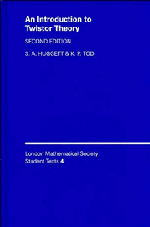Book contents
- Frontmatter
- Contents
- Preface
- Preface to the second edition
- 1 Introduction
- 2 Review of Tensor Algebra and Calculus
- 3 Lorentzian Spinors at a Point
- 4 Spinor Fields
- 5 Compactified Minkowski Space
- 6 The Geometry of Null Congruences
- 7 The Geometry of Twistor Space
- 8 Solving the Zero Rest Mass Equations I
- 9 Sheaf Cohomology and Free Fields
- 10 Solving the Zero Rest Mass Equations II
- 11 The Twisted Photon and Yang–Mills Constructions
- 12 The Non-Linear Graviton
- 13 Penrose's Quasi-Local Momentum and Angular Momentum
- 14 Functionals on Zero Rest Mass Fields
- 15 Further Developments and Conclusions
- 16 Hints, Solutions and Notes to the Exercises
- Appendix The GHP Equations
- Bibliography
- Index
9 - Sheaf Cohomology and Free Fields
Published online by Cambridge University Press: 25 January 2010
- Frontmatter
- Contents
- Preface
- Preface to the second edition
- 1 Introduction
- 2 Review of Tensor Algebra and Calculus
- 3 Lorentzian Spinors at a Point
- 4 Spinor Fields
- 5 Compactified Minkowski Space
- 6 The Geometry of Null Congruences
- 7 The Geometry of Twistor Space
- 8 Solving the Zero Rest Mass Equations I
- 9 Sheaf Cohomology and Free Fields
- 10 Solving the Zero Rest Mass Equations II
- 11 The Twisted Photon and Yang–Mills Constructions
- 12 The Non-Linear Graviton
- 13 Penrose's Quasi-Local Momentum and Angular Momentum
- 14 Functionals on Zero Rest Mass Fields
- 15 Further Developments and Conclusions
- 16 Hints, Solutions and Notes to the Exercises
- Appendix The GHP Equations
- Bibliography
- Index
Summary
We saw in the last chapter that in order to make the relationship between twistor functions and zero rest mass fields precise we seem to need to study certain collections of these (holomorphic) twistor functions. These collections are actually well-known to the mathematician: they arise naturally in the context of sheaf cohomology.
We start by reviewing the essential ideas behind analytic continuation of complex functions. This will quickly lead us to discuss Riemann surfaces and sheaves.
Consider an analytic function f : D → C, where D ⊂ C is a domain (that is, an open connected set). Under what circumstances can we extend f so that it is defined (and still analytic) on some larger set than D? Well, as usual, the analyticity allows us to push out the boundaries of D until the ‘natural boundary’ of f (a singularity of some sort) is reached. It frequently happens that in doing this the function f gets continued back to a point z ∈ D, but takes a different value there from its original one. The archetypical example, of course, is the logarithm. We therefore seem to be obliged to study multivalued functions, unless we can somehow absorb this behaviour into the space on which f is defined.
More precisely, we define a function element to be a pair (f, D) where f is analytic on the domain D.
- Type
- Chapter
- Information
- An Introduction to Twistor Theory , pp. 71 - 90Publisher: Cambridge University PressPrint publication year: 1994



